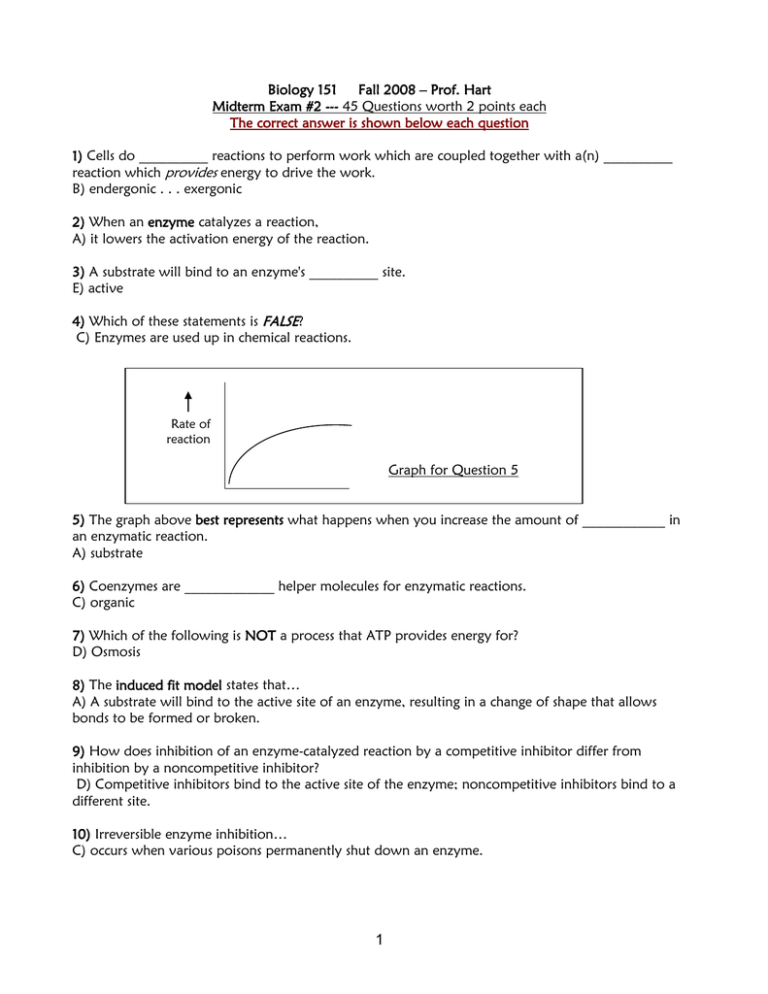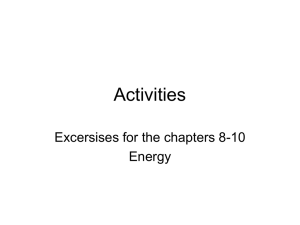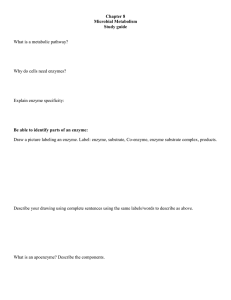Biology 151 Fall 2008 – Prof. Hart
advertisement

Biology 151 Fall 2008 – Prof. Hart Midterm Exam #2 --- 45 Questions worth 2 points each The correct answer is shown below each question 1) Cells do __________ reactions to perform work which are coupled together with a(n) __________ reaction which provides energy to drive the work. B) endergonic . . . exergonic 2) When an enzyme catalyzes a reaction, A) it lowers the activation energy of the reaction. 3) A substrate will bind to an enzyme's __________ site. E) active 4) Which of these statements is FALSE? C) Enzymes are used up in chemical reactions. Rate of reaction Graph for Question 5 5) The graph above best represents what happens when you increase the amount of ____________ in an enzymatic reaction. A) substrate 6) Coenzymes are _____________ helper molecules for enzymatic reactions. C) organic 7) Which of the following is NOT a process that ATP provides energy for? D) Osmosis 8) The induced fit model states that… A) A substrate will bind to the active site of an enzyme, resulting in a change of shape that allows bonds to be formed or broken. 9) How does inhibition of an enzyme-catalyzed reaction by a competitive inhibitor differ from inhibition by a noncompetitive inhibitor? D) Competitive inhibitors bind to the active site of the enzyme; noncompetitive inhibitors bind to a different site. 10) Irreversible enzyme inhibition… C) occurs when various poisons permanently shut down an enzyme. 1 11) During “redox” reactions… C) electrons are transferred from one molecule to another. 12) During cellular respiration, energy is transferred to electron-carrier molecules. Which of the following is a TRUE statement about this process? A) NADH and FADH2 accept electrons, while NAD+ and FAD+ give up electrons during the Electron Transport Chain. B) Molecular oxygen gives up electrons in the Electron Transport Chain in order to form water. C) FADH2 molecules are found in the cytoplasm of eukaryotic cells. D) None of the statements are true. 13) During which of the following phases of cellular respiration does substrate-level phosphorylation take place? E) glycolysis and the citric acid cycle 14) Which of the following is a result of glycolysis? C) conversion of glucose to two three-carbon compounds 15) The enzymes of the citric acid cycle are located in the… C) mitochondrial matrix. 16) During chemiosmosis… B) ATP is made when H+ ions move down their concentration gradient by passing through ATP synthase. 17) Which of the following statements about the inner mitochondrial membrane is FALSE? B) It plays a role in the production of pyruvate. 18) Cyanide differs from DNP because cyanide… B) blocks electron transport and DNP is an uncoupler. 19) A child is born with a rare disease in which mitochondria are missing from skeletal muscle cells. However, the muscles still function. How can a muscle cell continue to produce ATP in the absence of mitochondria? B) They can do lactic acid fermentation instead of cellular respiration. 20) Which of the following processes produces the most ATP per molecule of glucose oxidized? A) aerobic respiration 21) Yeast can produce ATP by either fermentation or oxidative phosphorylation; thus they are… C) facultative anaerobes. 22) Which of the following can be catabolized during glycolysis and cellular respiration? A) amino acids B) glycerol C) sugars D) fatty acids E) All of the above 2 23) In yeast cells, D) alcohol is produced after glycolysis. USE THIS FIGURE (ABOVE) TO ANSWER QUESTIONS 24 - 27 24) Molecule C is… D) citrate 25) Molecule A is… B) CO2 26) Molecule D is… E) FADH2 27) Molecule B is… A) reduced 28) The Light Reactions and the Electron Transport Chain are similar processes but they go in opposite directions. In the Light Reactions, ______ is a substrate, while in the Electron Transport Chain, this same molecule is created from atoms and electrons at the very end. C) H2O 29) As a result of glycolysis there is a net gain of __________ ATPs. C) 2 30) Which of the following is the correct reaction describing photosynthesis? C) 6 CO2 + 6 H2O + Energy --> C6H12O6 + 6O2 31) Compared to prokaryotic chromosomes, eukaryotic chromosomes… E) are housed in a membrane-enclosed nucleus. 32) The process by which the cytoplasm of a eukaryotic cell divides to produce two cells is called… B) cytokinesis. 33) In the cell cycle of a human cell, how many chromosomes does the cell have in the G2 phase? C) 92 3 34) The phase of mitosis during which the nuclear envelope fragments and the nucleolus disappears is called… B) prophase. 35) The cell-cycle control system… A) receives messages from outside of the cell that influence cell division. B) triggers and controls major events in the cell cycle. C) is influenced by growth factors that bind to cell receptors. D) includes three key checkpoints to complete a cell cycle. E) All of the choices are correct. 36) You are the director of research for a drug company. A list of candidate drugs is brought to you. Which of the following shows the GREATEST promise as a cancer chemotherapy agent? A drug that… C) prevents sister chromatids from separating at anaphase. 37) Which of the following is the correct order for the cell cycle: C) G1, S, G2, M For the following 4 questions (38-41), MATCH the cell cycle event with what happens during it (shown below): 38) The cell evaluates the DNA in order to determine that it has been properly replicated and is not damaged. = G2 checkpoint 39) The cell detects whether the microtubules, projecting from the centrosomes, are attached to all of the chromosomes. = Mcheckpoint 40) Forty-six human chromosomes are scanned for damage. = G1 checkpoint 41) DNA in the cell has experienced irreparable damage – the nucleus then fragments and the plasma membrane “blebs.”= Apoptosis 42) Cancer cells… A) no longer experience contact inhibition. B) undergo metastasis. C) can do angiogenesis. E) All of the above 43) “Virotherapy”… B) involves manipulating the genetic information of a virus so that it can kill cancer cells. 44) CDK and Cyclin… A) control the transition between G1 S and G2 M. B) are a family of proteins. C) will stop the cell cycle at 3 distinct places. D) All of the above 45) Genetic material is duplicated during… C) the S phase. 4

